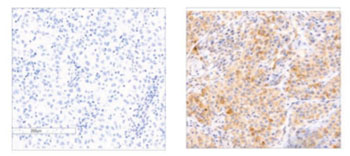Loss of Tumor Suppressor Gene Spurs Growth of Some Malignant Melanomas
By LabMedica International staff writers
Posted on 17 Nov 2015
Cancer researchers have identified a tumor suppressor gene that when damaged or lost acts to spur growth and spread of a subset of human malignant melanomas.Posted on 17 Nov 2015
Investigators at the Weizmann Institute of Science (Rehovot, Israel) reviewed data that had been accumulated during the genome and exome analysis of 501melanoma specimens. They reported in the October 26, 2015, online edition of the journal Nature Genetics that the RASA2 (RAS p21 protein activator 2) gene, which encodes a RasGAP (Ras GTPase activating protein), functioned as a tumor-suppressor gene that was mutated in 5% of melanomas.

Image: Metastatic melanoma tumors. The micrograph on the left shows low or absent expression of RASA2, which is linked to reduced survival of about 35% of patients. The sample on the right exhibits high RASA2 expression and increased survival (Photo courtesy of the Weizmann Institute of Science).
The protein encoded by RASA2 is located in the cytoplasm and is part of the GAP1 family of GTPase-activating proteins. The gene product stimulates the GTPase activity of normal RAS p21 but not its cancer-promoting counterpart. Acting as a suppressor of RAS function, the protein enhances the weak intrinsic GTPase activity of RAS proteins resulting in the inactive GDP-bound form of RAS, thereby allowing control of cellular proliferation and differentiation. Mutations leading to changes in the binding sites of either protein are associated with cancer formation.
Recurrent loss-of-function mutations in RASA2 were found to increase RAS activation, melanoma cell growth, and migration. RASA2 expression was lost in more than 30% of human melanomas and was associated with reduced patient survival.
"As the RAS pathway is highly dysregulated in cancer, the discovery of an alternative mechanism for its activation is likely to stimulate an avalanche of further research in this field, and is highly likely to have direct clinical relevance. We are now going to focus on RASA2, to find out what proteins it communicates with in healthy cells and melanoma, as well as in the cells' response to targeted therapy," said senior author Dr. Yardena Samuels, professor of molecular cell biology at the Weizmann Institute of Science.
Related Links:
Weizmann Institute of Science













